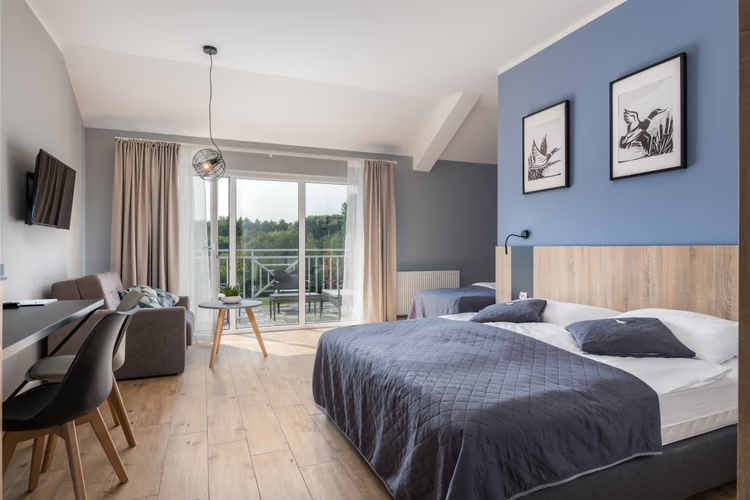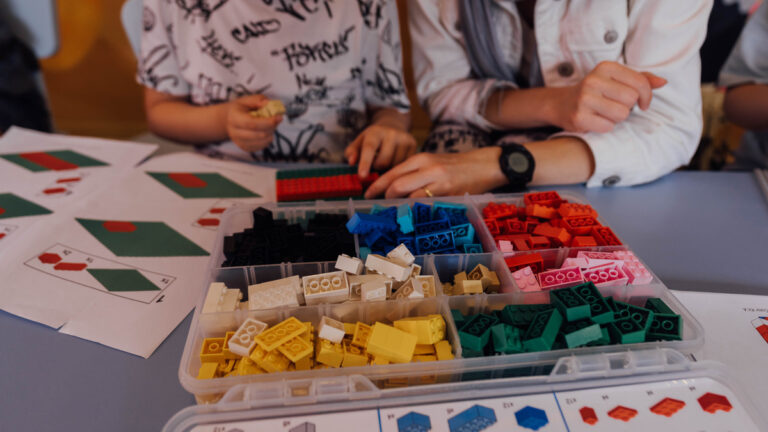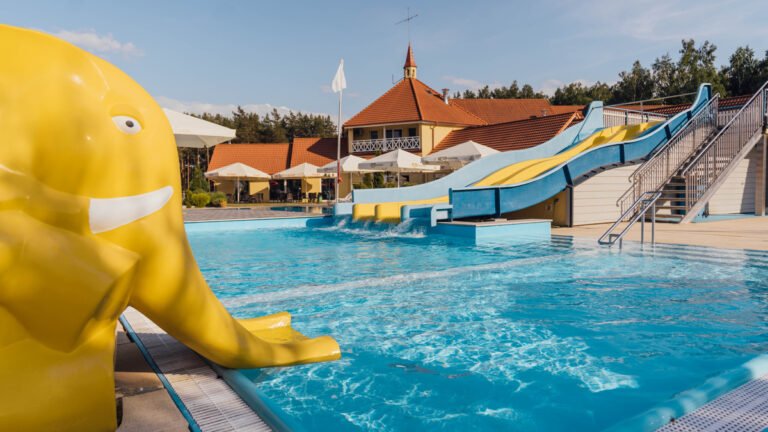Before you decide to jump into the Baltic Sea, it’s worth knowing whether it’s going to be a pleasant refresh or a quick sprint back to your towel. The sea can surprise you – one day it’s perfect for a long swim, the next… it puts you off at the first touch of water. Check how many degrees the Baltic has in different months, where it’s warmest and when it’s best to plan your holiday if you want swimming to be fun rather than a challenge. Especially if you’re travelling with children.
How warm is the Baltic Sea in July and August? See when swimming is really fun
In July and August the Baltic Sea reaches its highest temperatures – on average from 18 up to even 22°C, and locally (e.g. in Świnoujście or Puck Bay) it can reach as much as 25–26°C. That’s when the water is warmest and most welcoming for swimming – including for children. It’s also the best time to plan your holiday if you want to walk into the water comfortably, without chattering teeth.
The most favourable conditions usually occur between mid-July and the second half of August, but a lot depends on the exact spot. Beaches with a gentle slope and shallow shoreline – like the one in Łeba – warm up more quickly, which makes swimming conditions even better. At Kacze Stawy you can use a wide sandy beach with easy access to the sea, but if the weather lets you down, you also have a heated outdoor pool at your disposal, which works regardless of what the Baltic decides to do.
For families with children, this flexibility is a huge advantage. Water temperatures of over 20°C allow for long play in the sea without the risk of getting chilled or catching a cold. And if you’re staying with us, you can choose from seaside cottages at Kacze Stawy, which give you total freedom in planning your day – even if the weather changes halfway through your beach time.
Baltic Sea temperature – is it worth planning a holiday already in May?
In May the Baltic Sea temperature ranges on average from 2 to 12°C – with an upward trend in the last days of the month, especially in bays. In practice this means that an early dip in the sea can be quite a challenge – especially for children. It’s still not the time to talk about comfortable swimming, but… that doesn’t mean a May break at the seaside doesn’t make sense.
May is a great time for beach walks, playing in the sand, bike trips and getting your dose of iodine – without crowds, without heat, without the hustle and bustle. If you’re planning a family stay, the family rooms at Kacze Stawy let you plan your break in a rhythm that suits your pace. You don’t need to rely on warm water – because on site you already have everything you need for a great holiday.

Children can enjoy playgrounds, the mini zoo and animations, while adults can relax in the indoor pool or sauna. So if you dream of a quiet seaside break away from high-season chaos, May is a good option – just don’t count on long swims in the sea yet. At that time the water is better suited to quick dips, cold-water swimming or walks along the shoreline.
How cold is the Baltic Sea in winter – and why does it matter even if you’re not into winter swimming?
In the winter months the temperature of the Baltic can drop to as low as -1°C – especially in January and February. Under these conditions, we’re talking about ice-cold water, a challenge even for experienced winter swimmers. Interestingly, the sea doesn’t freeze easily despite sub-zero temperatures, thanks to the salinity of the water and constant movement. But swimming at this time is definitely for those seeking extreme experiences.
For most guests, the winter Baltic means seaside walks, admiring the empty beach and enjoying on-site facilities. If you’re staying at Kacze Stawy off-season, you have the comfort of cosy, warm cottages and full infrastructure. The indoor pool, wellness area and sauna make up for the lack of sea swimming, while the winter atmosphere of Łeba itself can be wonderfully soothing.
It’s also worth remembering that cold water affects health – and not just while you’re in it. The difference between air and water temperature can lead to thermal shock, especially in children and older people. That’s why even winter walks by the sea should be taken sensibly, in appropriate clothing and for moderate periods of time. And if you’re a fan of winter swimming, the beach in Łeba offers great conditions for it – but it’s best to do it with an experienced group or under the supervision of a lifeguard.
Where is the Baltic the warmest? Beaches with water up to 25°C
The warmest Baltic water is found in sheltered, shallow and well-sunlit places – such as Puck Bay, Świnoujście or Jarosławiec. In these spots the water can warm up in summer to 25–26°C, which – for the Baltic – is really impressive. Especially Świnoujście, which thanks to its location and wide, gently sloping beach is sometimes compared to southern resorts.
Puck Bay is another great choice for families – a shallow shoreline, quick warming and calm waves mean children feel safe and parents can truly relax. Jarosławiec, often mentioned as the warmest swimming spot on the Baltic, enjoys high water temperatures for much of the season – and it’s one of the places where many people take their first dip of the year already in June.
It’s worth keeping in mind that the temperature difference between these locations and the open sea can reach several degrees. So if you’re really keen on warm water, choose sheltered places – bays, harbours, beaches with gentle slopes. And if you’re staying in Łeba, you’ve got a great base – it’s easy to plan a trip to Świnoujście, Hel or Jarosławiec from here. At the same time you can enjoy the comfort of the seaside cottages at Kacze Stawy, with access to a heated outdoor pool if nature decides to play tricks.

How warm is the Baltic in Łeba? Comparing temperatures with other resorts
The average water temperature in Łeba in July and August ranges from 18 to 20°C, which is very similar to the temperatures in the Tricity area or Władysławowo, but slightly lower than in Świnoujście and Puck Bay. Łeba is located on the open sea, where the water warms up more slowly than in bays, but thanks to its wide beaches and excellent sun exposure, bathing conditions are very good – especially in the second half of summer.
What makes Łeba stand out is the quality of its beaches and the gentle entry into the sea, which is especially appreciated by families with children. In the summer season the water here reaches temperatures that allow for relaxed, enjoyable swimming – without the shock of cold at the first step. And if you visit Łeba outside peak season, for example in September, you can still expect water of around 17°C, which is enough for short dips in the sea on warmer days.
Take a dip in the Baltic Sea!
If you value comfort and flexibility, the family rooms at Kacze Stawy offer everything you need to balance sea bathing with full relaxation. No matter whether the weather cooperates 100%, you can still use the indoor pool, children’s animations, relaxation areas and full-board catering. That way, you’re not relying solely on the Baltic’s mood – even though a 20°C dip in crystal-clear water sounds pretty tempting, doesn’t it?
Baltic Sea temperature and children’s safety – what you need to know before going in
A safe water temperature for children’s bathing is at least 18°C, and ideally above 20°C. That’s why many families choose to go to the Baltic only in peak season, meaning July and August. At that time you can count on comfortable conditions both for adults and for the youngest, who love to splash in the water.
Water that’s too cold can lead to body cooling, muscle shivering and, in extreme cases, even cramps or fainting. With children in particular you need to be cautious and not allow long swims when the sea temperature drops below 18°C. Also remember that the difference between water and air temperature shouldn’t exceed 5–7°C – sudden immersion in cool water can trigger thermal shock.
So if you’re planning a holiday with kids, it’s worth choosing beaches with a Blue Flag and lifeguarded bathing zones, where safety is actively monitored along with weather and water conditions. At Kacze Stawy you have an extra option – an outdoor heated pool with paddling areas, which are perfect for little ones even on days when the Baltic isn’t particularly kind. It’s one of those things that gives you real peace of mind – especially when you want to make sure your children enjoy their holiday while you also look after their health and comfort.






